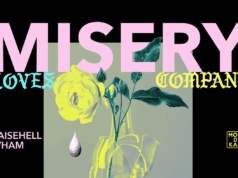a Solo Exhibit by Dennis Atienza

Opening
Saturday, October 3, 2020 | 4 PM UTC+08
J Studio
Pasillo 18, La Fuerza Gate 1 Compound,
2241 Chino Roces Avenue, 1200 Makati
Fantasy Armour
by Deeps De Guzman
Just when you thought that a character who is both a slave and a hero can only be found in legendary tales, you then realize he pales in comparison to the overseas Filipino worker.
Way back in 1995, I marveled at how the hand that played the haunting melody to Jim Croce’s “Time In A Bottle” note-for-note across the guitar fret was the very same hand that sketched dozens of anatomically correct human hands and feet that were so life-like, they virtually floated from the sheets of the cheap sketch book and stretched towards the viewer. Though I wish it were mine, that hand, I must declare, belongs to a longtime disciple of the arts, Dennis Atienza.
A Metrobank Art and Design Excellence second placer and a finalist of Shell National Painting Competition, Instituto Cervantes Letras Y Figuras, and the Philippine Art Awards, Dennis Atienza has participated in numerous group exhibitions since 2005, and has mounted solo exhibitions in 2009, 2010, and 2012. But I remember him best as a meticulous artist who enjoyed freehand drawing as much as drafting or technical drawing, at a time when friendship could only be enjoyed face-to-face, as Facebook or free chat apps were not created yet, and the price of a phone call would leave a gaping hole in one’s pocket.
Like a testament to the struggles of the Filipino-tightening-his-belt-and-making-ends-meet, Dennis Atienza had also dreamt of building a better future by working in another country, inspired in part by his father’s venture abroad. Yet once there, he realized that his mental and psychological resoluteness had not fully prepared him for the many stories of discrimination and indifference against overseas Filipino workers, whose dignity was often stripped off like acid effacing pigments on a painting.
Various shocking accounts of injustice sent Dennis Atienza’s jaw gaping. There’s Caloy, whose initial luck gaining employment in the house of a Saudi royalty turned topsy-turvy when, one day, he simply vanished, with no one being able to provide any lead to his possible whereabouts or how he could have just disappeared without a trace. There’s Jim, who, without any direct evidence, was found guilty merely because he was the last person to see his Arab employer, who had borrowed Jim’s vehicle to get to the beach… before his lifeless body was found floating in the sea. There’s also Janice, who kept getting beaten up by her “madame” for the most trivial of reasons, and kept getting verbally threatened, even when she gets sick due to overwork. Then, there’s Anna, whose original arrangement was to work only for a couple that had five children, but was thereafter “lent” to the husband’s brother, who eventually started raping her.
These are just a few of the stories that just stir the blood in our veins. Across the Kingdom, various incidents of wage discrimination, unpaid salary, verbal and physical abuse, starvation, excessive work hours, contract substitution, sexual harassment and rape, unsolved violent deaths, undocumented Filipino children abandoned by parents, delayed repatriation of the remains of deceased OFWs, and problems caused by the non-possession of an iqama abound. Despite the fact that slavery in Saudi Arabia has been abolished in 1962, old habits die hard: domestic workers continue to be treated unfairly and inhumanely.
Grim ordeals that some unfortunate overseas Filipino workers face are enough to break one’s spirit. Dennis Atienza recalls one OFW even saying that it’s difficult to survive there without getting a little crazy, as if implying everyone had to be. You would need to convert all the anxiety, fear, and discomfort that accumulates in you into a kind of mental anesthetic to avoid losing it. Most OFWs numb and steel themselves by keeping themselves busy all the time. After all, idle hands are the devil’s playground, and they already have enough demons to deal with on their own.
Dennis Atienza did not suffer as much as those whose harrowing experiences deeply affected him. But that is not to say he had it easy. In fact, he was, at one point, forced to part with all his belongings, save for a measly amount of money he had hidden in his trousers and the very clothes he was wearing at the time, but which left him feeling naked nonetheless. As he himself struggled to keep his sanity intact, he slowly became more and more aware of a world to which the OFWs escape, gradually imagining that special place where his fellow Filipinos retreat to in times of personal crises. Upon returning to the Philippines, Dennis Atienza set out to capture this realm of the subconscious in his paintings–that space between limbo and survival.
Most of Dennis Atienza’s paintings are sprinkled with hope and aspiration, with a tint of optimism and a hint of cynicism. The incessant longing to be justly heard and the yearning for redemption pervade each piece. The distinct inanimate objects found in each painting, seemingly unpretentious at first glance, communicate more than do the depicted human beings. The sharp edges and sleek contours in the foreground that clash with the hazy and muddled background are just as stubborn as the color schemes that refuse to blend, giving each hue its due.
In one particular series of paintings, Dennis Atienza appointed the suitcase as both the bearer of glad tidings and the harbinger of sorrow, with each stuffed bag, such as the one in “Cross Fire”, as poignant as the ones that are empty, just like the one in “Line Up 1 to 5”. We see the beaming face of a child between the two retractable arms of a suitcase handle in “Hand-me-down”, while a reddish hard hat looms over his head, like a crown he is destined to wear after all. The two human hands sticking out through the zipper lining of a large suitcase in “Escape Act” is terrifying enough to make you pray that they indeed manage to flee scot-free… and, heaven forbid, not be severed at all.
The OFW as a crow against the backdrop of a playing card is the subject of another series of paintings. The ace of heart in “Debonair” shows the Filipino’s penchant for looking good and putting on a good front all the time, and in the direst of times, keep up appearances. The ace of spades in “Braggart” shows that the haughty side of the Filipino is also what hides his insecurities. The ace of club in “Hen-pecked” shows the nagging side of the Filipino desperate for quick answers and hasty remedies. Finally, the ace of diamond in “Sire” represents the Filipino after having felt elevated to new heights; hence, the crown.
In another series of paintings, Dennis Atienza forged a balance between the real and the surreal. While perched on an open suitcase, the subject in “Balancing Imbalance” uses a locus yonder to find her center as she keeps opposing forces on each side at bay. In two other paintings, we see how each subject finds equilibrium, with “Vague” showing us what it’s like to see all your desires and wishes swirling around you–so close and yet so far, while “Superficial” shows us how jumping into the rabbit’s hole simply makes any moment of joy worth it, no matter how petty or fleeting it was. In addition, in a smaller body of work collectively called “A Glimmer of Hope”, we find each of the subject in four separate paintings clothed in a mist of temporal relief from the pangs of loneliness or the chains of isolation.
While his prospects might have been initially good when he first came to Saudi Arabia, much of Dennis Atienza’s experiences abroad became a stark contrast to the freedom he relishes when wielding a paint brush. Thus, armed with his brush and his promise to his fellow OFWs, he made it his quest to capture the sentiments of the overseas Filipino worker, one canvas at a time, to remind us that, oftentimes, the price that modern-day Filipino heroes need to pay just to reach the greener pasture on the other side of the fence is much, much costly than what many a Bagong Bayani had bargained for.
If a box, any box, were to arrive in the Philippines from anywhere at any given time, one simply prays that it not be the kind that is cold, silent, and draped with a flag. Truly, you would prefer receiving, from a loved one, an empty box a thousand times over than be forced to lay one six feet under. If Dennis Atienza’s OFW friends and acquaintances could see how his paintings pay tribute to the tenacity and the indomitable spirit of the overseas Filipino worker amid adversity and injustice, I swear, I’d be hearing them singing to him: “If I had a box just for wishes and dreams that had never come true, the box would be empty except for the memory of how they were answered by you.”
Regular gallery hours are from Tuesdays to Saturdays from 12 nn to 6 pm.
For appointment and reservation, kindly contact Ms. Genevieve Magisa:
Email: jstudiogallery2017@gmail.com
Contact/Viber us at: (+63) 935-537-6399
FB : J Studio / IG: artjstudio






























